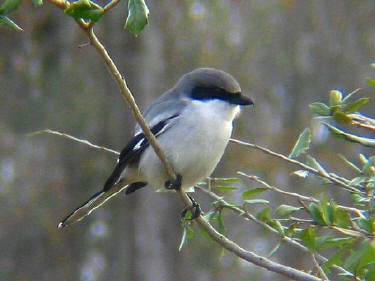SCIENTIFIC NAME:
Lanius ludovicianus
OTHER NAMES:
Butcher bird
STATUS:
Breeder. Fairly common in winter, spring, and fall, and uncommon in summer in all regions. HIGH CONSERVATION CONCERN.
DESCRIPTION:
A medium sized songbird (8-10 inches long) that regularly preys on small mammals and other songbirds; similar to the mockingbird in size and coloration. The head is bluish gray with a black mask surrounding the eyes and extending from the neck to the bill. The wings are black with a white patch on the primaries and the tail is black with white edges. The most distinguishing feature of this bird is its black hooked bill, which is slightly notched, hooked like a falcon and used to kill prey. The feet lack sharp talons, like hawks, but are strong with sharp claws. Males are slightly larger than females.
DISTRIBUTION:
Found throughout most of the United States except the Northeast, Rocky Mountains and Cascade Mountain Range. Southern portions of their range have resident populations while northern populations may migrate as far south as central Mexico during the winter. In Alabama, loggerhead shrikes are fairly common in winter, spring and fall throughout the state but are uncommon during the summer. Their status is of moderate conservation concern.
HABITAT:
Open grass areas such as pastures with fences, mowed rights of way, open shrub land, and agricultural areas. Prefers scattered shrubs and low trees for perching and nesting. These shrubs and trees are likely to be species with thorns.
FEEDING HABITS:
The shrike is the only predatory songbird in North America. Vertebrates such as mice, lizards, and snakes, as well as other songbirds, are preyed on by shrikes in winter months. Insects make up the majority of their summer diet. Grasshoppers, butterflies and beetles are favorites. Their lack of talons for holding and feeding on prey has led to their habit of impaling dead prey on thorns or barbed wire. This behavior allows the food to be stabilized while eating and provides a food cache for future use. Having excellent eyesight, they will perch and scan open areas for prey much like a hawk does.
LIFE HISTORY AND ECOLOGY:
In the southern portions of their range shrikes will mate as early as February and March with migratory populations breeding later in April and May. Males will use impaled prey as a display to attract females and will actually kill prey it does not need for food to show his ability to provide for a mate. Loggerhead shrikes are very territorial and both sexes will defend feeding, roosting and nest sites. Nests are always built in trees or shrubs three feet or more off the ground, are cup shaped and made of sticks, twigs and moss. The female usually assembles the nest from materials the male brings to her. She will incubate four to seven eggs for 16 to 17 days while the male brings her food. Both the male and female feed the nestlings. Fledging takes 17 to 21 days after hatching and adults will care for the young three to four weeks after fledging. The female will lay another clutch and start incubation while the male tends to the young. Two clutches are often raised per year.
REFERENCES:
Hall, S.P., LeGrand, H.E., Jr., and Fisher, R.A. (1997). “Species profile: Loggerhead shrike (Lanius ludovicianus) on Military installations in the southeastern United States, “Technical Report SERDP-97-O8, U.S. Army Engineer Waterways Experimental Station, Vicksburg, MS.
Mirarchi, R. E., ed. 2004. Alabama wildlife. Volume 1. A checklist of vertebrates and selected invertebrates: Aquatic mollusks, fishes, amphibians, birds, and mammals. The University of Alabama Press, Tuscaloosa. 209pp.
Author:
Paul Carver, Wildlife Biologist, Division of Wildlife and Freshwater Fisheries.






